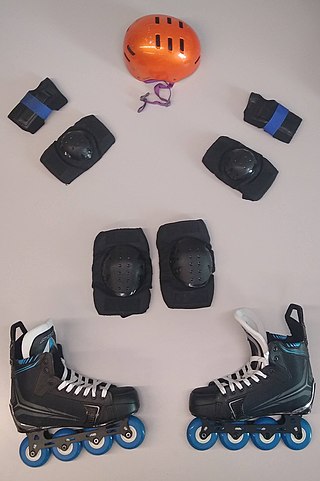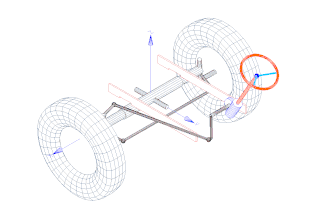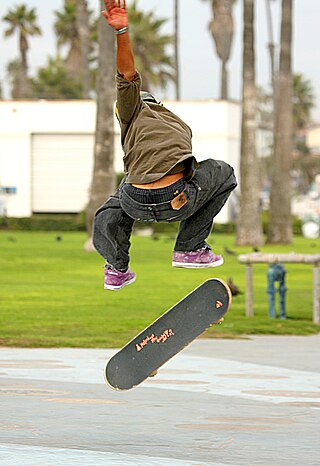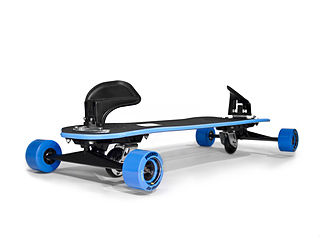
Snowboards are boards where the user places both feet, usually secured, to the same board. The board itself is wider than most skis, with the ability to glide on snow. Snowboards widths are between 6 and 12 inches or 15 to 30 centimeters. Snowboards are differentiated from monoskis by the stance of the user. In monoskiing, the user stands with feet inline with direction of travel, whereas in snowboarding, users stand with feet transverse to the longitude of the board. Users of such equipment may be referred to as snowboarders. Commercial snowboards generally require extra equipment such as bindings and special boots which help secure both feet of a snowboarder, who generally ride in an upright position. These types of boards are commonly used by people at ski hills, mountains, backcountry, or resorts for leisure, entertainment, and competitive purposes in the activity called snowboarding.
Boardsports are active outdoor sports that are played with some sort of board as the primary equipment. These sports take place on a variety of terrains, from paved flat-ground and snow-covered hills to water and air. Most boardsports are considered action sports or extreme sports, and thus often appeal to youth. Some board sports were marginalized in the past. However, many board sports are gaining mainstream recognition, and with this recognition, they have enjoyed wider broadcast, sponsorship and inclusion in institutional sporting events, including the Olympic Games.

Inline skates are a type of roller skate used for inline skating. Unlike typical roller skates, which have two front and two rear wheels, inline skates typically have two to five wheels arranged in a single line. Some, especially those for recreation, have a rubber "stop" or "brake" block attached to the rear of one or occasionally both of the skates so that the skater can slow down or stop by leaning back on the foot with the brake skate.

A half-pipe is a structure used in gravity extreme sports such as snowboarding, skateboarding, skiing, freestyle BMX, skating, and scooter riding.
A Snakeboard, also known as streetboard, or pivotboard is a board that was invented in South Africa in 1989 by James Fisher, Simon King and Oliver Macleod Smith. The concept was to fuse the original skateboard with elements of snowboarding and surfing to create a fun riding experience. The first prototype was constructed using two square wooden boards, an old roller skate chopped in half, and a piece of plumbing pipe to join them together. Many variants were tried before manufacturing began. The first boards to be mass-produced were made from a strong plastic nylon known as Zytel ST801.

A longboard is a type of skateboard typified by longer decks and wheelbases, larger-diameter and softer (lower-durometer) wheels, and often lower riding height compared to street skateboards, though there is wide variation in the geometry and construction of longboards. Among the earliest types of skateboards, longboards were inspired by surfing, with early longboards drawing from the design of surfboards, resembling and mimicking the motion of riding a surfboard, but adapted to riding on streets in a practice known as sidewalk surfing.

Longboarding is a variation of skateboarding typified by the use of longer boards ("decks") with longer wheelbases and softer wheels. While longboards vary widely in shape and size, compared to street skateboards longboards are designed to be more stable at speed and to have more traction due to larger wheel sizes and softer wheel durometers. While standard street skateboards may typically be between 28 and 34 inches long, longboards can range anywhere from 32 to 50 inches in length. Ride characteristics of longboards generally differ from that of street skateboards due to the use of specialized longboard trucks that have different properties than those typically used with skateboards; while street skateboards use "traditional kingpin" (TKP) trucks that are optimized for tight turning radii, ollie and flip tricks, slides, grinds, and transition skating, longboards are typically paired with "reverse kingpin" (RKP) trucks that are designed for increased stability at higher speeds, more "surfy" carving characteristics, and/or greater ride comfort for commuting over longer distances.

Mountainboarding, also known as dirtboarding, off-road boarding, and All-Terrain Boarding (ATB), is a well-established but little-known action sport, derived from snowboarding. The sport was initially pioneered by James Stanley during a visit to the Matterhorn in the 1990s, where snow was not available. A mountainboard is made up of components including a deck, bindings, four wheels with pneumatic tires, and two steering mechanisms known as trucks. Mountainboarders, also known as riders, ride specifically designed boardercross tracks, slopestyle parks, grass hills, woodlands, gravel tracks, streets, skateparks, ski resorts, BMX courses, and mountain bike trails. It is this ability to ride such a variety of terrain that makes mountainboarding unique from other board sports.

Street luge is an extreme gravity-powered activity that involves riding a street luge board down a paved road or course. Street luge is also known as land luge or road luge. Like skateboarding, street luge is often done for sport and for recreation.

Dirtsurfing is the sport of riding a Dirtsurfer brand inline board. This new Australian boardsport is correctly known as inline boarding because Dirtsurfer is a trademark protected brand name.

A kick scooter is a human-powered street vehicle with a handlebar, deck, and wheels propelled by a rider pushing off the ground with their leg. Today the most common scooters are made of aluminum, titanium, and steel. Some kick scooters made for younger children have 3 to 4 wheels and are made of plastic and do not fold. High-performance kickbikes are also made. A company that had once made the Razor Scooters revitalized the design in the mid-nineties and early two-thousands. Three-wheel models where the frame forks into two decks are known as Y scooters or trikkes.
A freestyle skateboarding trick is a trick performed with a skateboard while freestyle skateboarding. Some of these tricks are done in a stationary position, unlike many other skateboarding tricks. The keys to a good freestyle contest run are variety, difficulty, fluidity, and creativity. This is an incomplete list, which includes most notable tricks.

A slide is a skateboarding trick where the skateboarder slides sideways either on the deck or the trucks.

A caster board, vigorboard or waveboard is a two-wheeled, human-powered land vehicle. Other names are J-board and RipStik, both of which are derived from commercial brands.

Bump steer is the term for the tendency of the wheel of a car to steer itself as it moves through the suspension stroke.

A skateboard is a type of sports equipment used for skateboarding. It is usually made of a specially designed 7–8-ply maple plywood deck and has polyurethane wheels attached to the underside by a pair of skateboarding trucks.
A fingerboard is a scaled-down replica of a skateboard that a person "rides" with their fingers, rather than their feet. A fingerboard is typically 100 millimeters (3.9 in) long with width ranging from 26 to 55 mm, with graphics, trucks and plastic or ball-bearing wheels, like a skateboard. A fingerboard can be used to do traditional skateboarding tricks, such as an ollie and kickflip.

A freeboard is a specialist skateboard designed to closely simulate the behavior of a snowboard. Freeboards were developed to allow snowboarders to transition to skateboarding without the need to adapt to a smaller deck and narrower wheel-base.

A brakeboard is a skateboard fitted with a specialised truck assembly that includes a braking mechanism.















